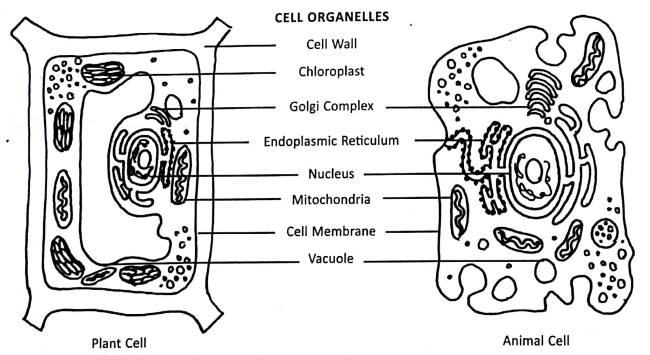
1
The Cell - Its Structure and Function
Keywords
Cell
Basic Structural and functional unit of life.
Cell membrane
a thin membrane that surrounds the protoplasm of every cell.
Cell organelles
a specialised sub-unit within a cell,that has a specific function.
genes
unit of inheritance which gets tranfered from one generation to the next.
Cytoplasm
portion of protoplasm, lying between the cell membrane and the nuclear membrane.
Tissue
group of cell performing a specialised function.
A. Fill in the blanks.
1. All living organisms are made up of cells.
2. The cell wall provides rigidity and protection to the plant cell.
3. All cellular activities are controlled by the nucleus .
4. The mitochondria is known as the powerhouse of the cell.
5. tissue is a group of cells performing a specific function.
6. It was Robert Hooke who observed cells for the first time.
B. Match the following.

Answer: (1) d, (2) e, (3) a, (4) b, (5) c
C. Tick the correct option.
1. The cell organelle, which acts as a storage bag for a cell, is known as the-
Answer: vacuole
2. Hen’s egg is-
Answer: a single cell
3. The nucleus is separated from the cytoplasm by the-
Answer: nuclear membrane
4. Which of the following will not be found in an egg cell, human liver cell and an Amoeba?
Answer: cell wall
5. Which of the following represents the correct sequence?
Answer: cell → tissue → organ → organ system
6. Which, amongst the following pairs, can be found only in a plant cell but not in an animal cell?
Answer: cell wall and plastids
D. Answer the following questions in brief.
1. List the (main) factors that determine the shape of a cell.
Answer: The (main) factors that determine the shape of a cell are location and function.
2. Distinguish between unicellular and multicellular organisms. Give two examples of each.
Answer: Distinguish between unicellular and multicellular organisms are
Unicellular organisms are made up of a single cell. e.g., Euglena and Amoeba.
Multicellular organisms are made up of many cells. e.g., Humans and Birds.
3. Give reasons for the following:
(a) The cell is called the structural and functional unit of life.
Answer: All organisms are made up of cells. A cell is capable of independent existence. Due to this, cell is called the structural and functional unit of life.
(b) Plant cells are more rigid than the animal cells.
Answer: Cell wall is present in plant cell. Due to this, plant cells are more rigid than animal cells.
4. Which cell organelle is known as the ‘Powerhouse of the cell? Why is it so called?
Answer: Mitochondria is known as the Powerhouse of the cell.
Mitochondria are the site of cellular respiration. Energy is produced during this process. Due to this, mitochondria are called the Powerhouse of the cell.
5. Name the cell organelles responsible for imparting colour to the leaves and fruits of a plant.
Answer: Chloroplast is responsible for imparting colour to the leaves. Chromoplast is responsible for imparting colour to fruits.
6. What are cilia and flagella? Write one similarity and one dissimilarity between the two of them.
Answer: Cilia and flagella are extensions on the cell membrane, these help in locomotion and procurement of food in organisms like Amoeba and Paramoecium. Cilia are much smaller than flagella.
7. If onion peel cells and cheek cells are observed through a microscope, state the two major differences that the observer is likely to find.
Answer: the two major differences that the observer is likely to find are:
In Onion peel cells:
- Cells are arranged in rows.
- Cell wall is present.
In Cheek cells:
- Cells randomly arranged.
- Cell wall is absent.
8. Classify the following into cells, tissue and organ.
skin, fat cell, RBC, blood, ear, muscle
Answer: Cell: Fat cell and RBC.
Tissue: Blood and muscle.
Organ: Skin and ear.



0 Comments